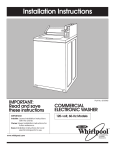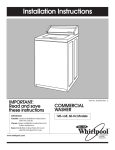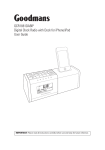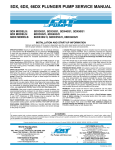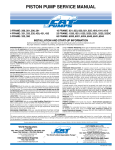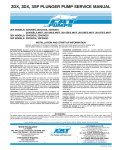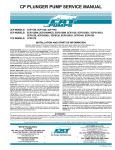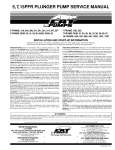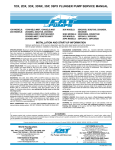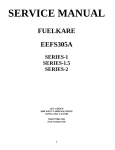Download 2SF, 2SFX, 4SF SERVICE MANUAL
Transcript
2SF, 2SFX, 4SF SERVICE MANUAL ® 2SF, 2SFX, 2SFCEE PLUNGER MODELS 2SF10, 2SF20, 2SF22, 2SF25, 2SF29, 2SF30, 2SF35 4SF PLUNGER MODELS 4SF32ELS, 4SF40ELS, 4SF45ELS, 4SF50ELS, 4SF30GS1, 4SF35GS1, 4SF40GS1, 4SF45GS1, 4SF45GS118, 4SF50GS1 CAUTION: CAT PUMPS are positive displacement pumps. Therefore, a properly designed pressure RELIEF OR SAFETY VALVE MUST BE INSTALLED in the discharge piping. Failure to install such a relief mechanism could result in personal injury or damage to the pump or system. CAT PUMPS does not assume any liability or responsibility for the operation of a customer’s high pressure system. INSTALLATION AND START-UP INFORMATION Optimum performance of the pump is dependent upon the entire fluid system and will be obtained only with the proper selection, installation of plumbing and operation of the pump and accessories. SPECIFICATIONS: Maximum specifications refer to individual attributes. It is not implied that all maximums can be performed simultaneously. If more than one maximum is considered, check with your CAT PUMPS supplier to confirm the proper performance and pump selection. LUBRICATION: Fill crankcase with special CAT PUMP Hydraulic oil per pump specifications. DO NOT RUN PUMP WITHOUT OIL IN CRANKCASE. Change initial fill after 50 hours running period. Thereafter, change oil every 3 months or 500 hour intervals. MOTOR SELECTION: Identify the pump shaft size. (2SF) “ES” and “ELS” models have 5/8" electric shaft; “GES” models have 3/4" electric shaft, “GS”, “GZ” models have 3/4" gas shaft. (4SF) “ELS” models have 1-1/8" electric shaft; “GS” models have a 1" gas shaft. The motor or engine driving the pump must be of adequate horsepower to maintain full RPM when the pump is under load. Select the electric motor from the Horsepower Requirement Chart according to required pump discharge volume and maximum pressure at the pump! Consult the manufacturer of gas or diesel engine for selection of the proper engine. MOUNT THE PUMP: All 2SF and 4SF are direct drive and do not need to be mounted to another surface. Only the solid shaft 2SF22SLS with attachment brackets needs to be mounted to a rigid, horizontal surface. An uneven mounting surface will cause extensive damage to the pump base. Use the correct belt; make sure pulleys are aligned. Excessive belt tension may be harmful to the bearings. To minimize piping stress, use appropriate flexible hose to inlet and discharge ports. Before mounting pump to motor or gas engine, apply PN 6106 antiseize lubricant to pump shaft. Refer to Technical Bulletin #055 for instructions on removing pump from gas engine or electric motor. LOCATION: If the pump is used in extremely dirty or humid conditions, it is recommended pump be enclosed. Do not store or operate in excessively high temperature areas or without proper ventilation. INLET CONDITIONS: Refer to complete Inlet Condition Check-List in this manual before starting system. DO NOT STARVE THE PUMP OR RUN DRY. DISCHARGE PLUMBING: OPEN ALL VALVES BEFORE STARTING SYSTEM to avoid deadhead overpressure condition and severe damage to the pump or system. A reliable Pressure Gauge should be installed near the discharge outlet of the high pressure manifold. This is extremely important for adjusting pressure regulating devices and also for proper sizing of the nozzle or restricting orifice. The pump is rated for a maximum pressure; this is the pressure which would be read at the discharge manifold of the pump, NOT AT THE GUN OR NOZZLE. All 2SF and 4SF Pumps come complete with a Pressure Regulating Unloader. NOTE: Except “CEE” Models. A Pressure Regulator or Unloader Valve must be installed to prevent over pressurizing the pump in the event the discharge or downstream plumbing becomes plugged or is turned off. Severe damage to the pump will result if this condition occurs without a relief valve in the line. CAUTION: Failure to install such a safety valve will void the warranty on the pump. Discharge regulating devices should be at minimum pressure setting at start-up. On systems over 2000 PSI SECONDARY PROTECTION is recommended by installing a pop-off valve, safety valve or rupture disc. START SYSTEM WITH ALL VALVES OPEN OR IN THE LOW PRESSURE SETTING. Use PTFE liquid (sparingly) or tape to connect accessories or plumbing. Exercise caution not to wrap tape beyond the last thread to avoid tape from becoming lodged in the pump or accessories. This condition will cause a malfunction of the pump or system. NOZZLES: A worn nozzle will result in loss of pressure. Do not adjust pressure regulating device to compensate. Replace nozzle and reset regulating device to system pressure. PUMPED FLUIDS: Some fluids may require a flush between operations or before storing. For pumping fluids other than water, contact your CAT PUMPS supplier. STORING: For extended storing or between use in cold climates, drain all pumped fluids from pump and flush with antifreeze solution to prevent freezing and damage to the pump. DO NOT RUN PUMP WITH FROZEN FLUID. Products described hereon are covered by one or more of the following U.S. patents 3558244, 3652188, 3809508, 3920356, 3930756 and 5035580 CAT PUMPS (U.K.) LTD. World Headquarters CAT PUMPS 1681 - 94th Lane N.E. Minneapolis, MN 55449 - 4324 Phone (612) 780-5440 — FAX (612) 780-2958 e-mail: [email protected] www.catpumps.com International Inquiries FAX (612) 785-4329 e-mail: [email protected] 1 Fleet Business Park, Sandy Lane, Church Crookham, Fleet Hampshire GU13 OBF, England Phone Fleet 44 1252-622031 — Fax 44 1252-626655 N.V. CAT PUMPS INTERNATIONAL S. A. ® The Pump with “Nine Lives” Heiveldekens 6A, 2550 Kontich, Belgium Phone 32- 3- 450.71.50 — Fax 32-3- 450.71.51 e-mail: [email protected] CAT PUMPS DEUTSCHLAND GmbH Buchwiese 2, D-65510 Idstein, Germany Phone 49 6126-93030 — Fax 49 6126-930333 e-mail: [email protected] www.catpumps.de Fig. A Fig. B Fig. C SERVICING THE PUMPING SECTION DISASSEMBLY OF THE DISCHARGE VALVE ASSEMBLY 1. 2. 3. 4. 5. 6. 7. 4. Disconnect all plumbing and remove unloader for ease in servicing. NOTE: CEE models do not come with standard unloader. Inspect oil for proper level, presence of water or discoloration and replace as needed. With a standard M6 allen wrench remove the six (6) (2SF) or eight (8) (4SF) Socket Head Screws from the manifold. Remove the outer screws first, then the center screws. (Fig. A) With a soft mallet tap the back side of the Discharge Manifold from alternate sides to maintain alignment and avoid damage to the plungers. (Fig. B) Grasp the Discharge Manifold from the from underside and gradually lift manifold while you pull away from the Crankcase. The Adapter/Spacers may stay with either the Discharge or Inlet Manifold. By inserting two opposing screwdrivers between Spacer and manifold you can easily pry them out of the Discharge Manifold.(Fig. C) If they stay in the Inlet Manifold, gently work them up and down as you pull away from the Inlet Manifold. (Fig. D) The valve assemblies are in the Discharge Manifold ports and will fall out when manifold is turned over. A complete valve assembly includes: Retainer, Spring, Valve and Seat. (Fig. E) NOTE: On “X” versions the Valve and Spacer are one-piece. NOTE: The “GZ” models use the standard “SF” Valve Kit. DISASSEMBLY OF THE SEAL ASSEMBLY 1. 2. 3. 6. REASSEMBLY OF SEAL ASSEMBLY 1. 2. 3. 4. 5. 6. 7. Next remove the Inlet Valve Assembly from the exposed plunger rod ends, including Cotterpin, Nut, Washer, Spring, Spacer and Inlet Valve.(Fig. F) Grasp the Inlet Manifold from the front and underside and pull to remove from Plunger Rods.(Fig. G) Carefully examine back side of Lo-Pressure Seal before removing from manifold as it will be damaged during removal. If worn, insert screwdriver into I. D. of seal and pry out. Exercise caution to avoid damage to the Inlet Manifold. (Fig. H) Fig. D 5. Fig. E Next press ceramic Plunger with thumb or soft tool from back side of Inlet Manifold. (2SF) The Hi-Pressure Seal may stay with the plungers or remain in the Inlet Manifold. If on the plungers, slide off by hand. If in the manifold, use a reverse pliers to remove. (4SF) The V-Packing and Adapters may stay with the plungers or remain in Inlet Manifold. If on the plungers, slide off by hand. If in the manifold, use a reverse pliers to remove. Then remove Seal Retainers from Crankcase by grasping tab with pliers and pulling out. Examine Crankcase Oil Seal to determine if Crankcase servicing is needed. (Fig I) Examine Seal Retainers and replace if worn or damaged. Install on Plunger Rod and press into Crankcase with tab out. Place Inlet Manifold on work surface with Crankcase side up. Lubricate new Lo-Pressure Seal and press into position with garter spring down. Be certain the seal is seated squarely on the shoulder on the inlet manifold chamber.(Fig. J) Place Inlet Manifold on work surface with Crankcase side down (larger I.D. ports up). (4SF) Place new Female Adapter into Inlet Manifold chamber with v-groove facing up. Carefully examine the Plungers for scoring or cracks and replace if worn. (2SF) Lubricate Ceramic Plungers and new Hi-Pressure Seals. Press the plunger into the seal and position seal in middle of plunger. NOTE: Place the deeper recessed end of the plunger into the seal from the metal back side. NOTE: The “Hi-Temp” 2SF models use a special Hi-Pressure Seal and Hi-Temp Seal Kit. (4SF) Lubricate Ceramic Plungers and new V-Packings. Press Plunger into the V-Packings and position in the middle of plunger. (Fig. K) NOTE: The deeper recessed end of the plunger should face the same direction as the v-groove on the V-Packing. (Fig. L) Fig. F 2SF Fig. G 8. 9. 10. 11. 12. 13. 14. 15. Fig. H Insert the Plungers into the manifold ports [4SF with v-groove facing up.] Press into position using the larger I.D. end of Discharge Valve Spacer. Note the "S" versions of the 4SF pumps have a replaceable Sleeve. Examine the Sleeve for grooves or scale build up and replace as needed. Grasp the Sleeve by hand and pull from the Plunger Rod. Examine the O-Ring and Back-up-Ring under the Sleeve for cuts or wear and replace. Examine the Barrier Slinger for wear and replace as needed. Install the Barrier Slinger with the concave side facing away from the Crankcase. Lubricate the Plunger Rod O-Ring to avoid cutting during installation. Install the Back-up-Ring first then the O-Ring into the groove on the Plunger Rod. Next install the Sleeve with the tapered end facing out. Gently press towards the Plunger Rod shoulder until flush with the Barrier Slinger. Carefully install Inlet Manifold over Plunger Rod ends and slowly press into Crankcase. Examine Inlet Valve and replace if worn. Inlet valves cannot be reversed if worn. The S.S. Inlet Valves may be lapped if not badly worn. Install the S.S. Inlet valves with square edges towards the plungers (round edges towards the discharge). Install the Nylon Inlet Valve with ridged side towards the discharge. NOTE: The “Hi-Temp” 2SF models use a Nylon Inlet Valve (order individual parts, not standard Inlet Valve Kit). Examine Spacers for wear and replace as needed. Install Spacer on each Plunger Rod with smaller O.D. towards inlet valve. Examine Springs for damage or fatigue and replace as needed. Place on Plunger Rods. Install Washers next with concave side towards Inlet Manifold. Next install Nuts and torque to specifications. On 2SF and 4SF models always install new Cotterpins and turn ends to secure in position. NOTE: “X” version does not use Cotterpin. REASSEMBLY OF THE DISCHARGE VALVE ASSEMBLY 1. Examine Adapter Spacer O-Rings and replace if worn. Lubricate and install O-Rings and Back-up-Rings on both front and rear of the Adapter Spacer. (Fig. M) Fig. J Fig. K 4SF Fig. I 2. Examine the Valve Retainers for scale build up or wear and install into each Discharge Manifold port with tab down into the manifold chamber. 3. Replace worn or damaged Springs and place into Retainers. 4. Examine Valve and Seats for pitting, grooves or wear and replace as needed. 5. Place Valves over Springs with concave side down. 6. Place Valve Seats on Valves with concave side down. NOTE: On 2SF “X” models, Seat and Adapter are one-piece. 7. Lubricate O.D. of Adapter/Spacer and insert smaller I.D. into Discharge Manifold ports. Snap into position. Exercise caution not to cut or pinch o-rings. 8. Carefully guide Discharge Manifold with Spacers over Plunger Rod ends and press into Inlet Manifold. 9. Replace Socket Head Screws and torque to specifications. Use torque sequence chart (Fig. N). 10. If oil was not changed, be certain oil is to mark on Oil Gauge before resuming operation. 2SF Torque Sequence 4SF Torque Sequence 1 3 5 6 4 7 1 3 5 6 4 2 8 2 Fig. N Torque diagonally in order shown. The outer four (4) screws then center screws all hand tight. Then repeat series to specifications in torque chart. SERVICING THE CRANKCASE SECTION 1. 2. 3. 4. 5. While Inlet Manifold, Plungers and Seal Retainers are removed, examine Crankcase Seals for wear. Check oil level and for evidence of water in oil. Rotate Crankshaft by hand to feel for smooth bearing movement. Examine Crankshaft Oil Seal externally for drying, cracking or leaking. Consult factory or your local distributor if Crankcase service is required. Fig. L INLET CONDITION CHECK-LIST Review Before Start-Up Inadequate inlet conditions can cause serious malfunctions in the best designed pump. Surprisingly, the simplest of things can cause the most severe problems or go unnoticed to the unfamiliar or untrained eye. REVIEW THIS CHECK-LIST BEFORE OPERATION OF ANY SYSTEM. Remember, no two systems are alike, so there can be no ONE best way to set-up a system. All factors must be carefully considered. Fig. M PREVENTATIVE MAINTENANCE CHECK-LIST Check Daily Clean Filters Oil Level/Quality Oil Leaks Water Leaks Belts, Pulley Plumbing Initial Oil Change Oil Change Seal Change Valve Change Accessories Weekly 50 hrs. 500 hrs.* 1500 hrs.** x x x x x x x x x x x *If other than CAT PUMPS special multi-viscosity ISO68 oil is used, change cycle should be every 300 hours. **Each system’s maintenance cycle will be exclusive. If system performance decreases, check immediately. If no wear at 1500 hours, check again at 2000 hours and each 500 hours until wear is observed. **Remember to service the regulator/unloader at each seal servicing and check all system accessories and connections before resuming operation. TORQUE CHART Pump Item Outer Bearing Case Screw Inner Bearing Case Screw Manifold Screw Plunger Rod Nut Bubble Oil Gauge Thread Tool Size [Part No.] Torque in. lbs. ft. lbs. Nm M6 M10 Hex/Phil. 50 [25082] M6 M10 Hex/Phil. 50 [25082] M8 M6 Allen 115 [30941] M6 M10 Hex 55 [25082] M28 Oil Gauge Tool 45 [44050] 4.0 6 4.0 6 9.4 13 4.4 6 3.6 5 10 12 12 Mounting 2SF Adapter Plate to Gas Engine 5/16-24 3/8-16 Pump to Adapter Plate Pump to Electric Motor 3/8-16 1/2" Hex 9/16" Hex 9/16" Hex 90 110 110 7.2 9.0 9.0 9/16" Hex 3/4" Hex 3/4" Hex 110 150 150 9.0 12 12.5 17 12.5 17 Mounting 4SF Adapter Plate to Gas Engine Pump to Adapter Plate Pump to Electric Motor 3/8-16 1/2-13 1/2-13 TECHNICAL BULLETIN REFERENCE CHART No. 043 055 057 065 070 073 074 075 Subject Plunger Pump LPS and HPS Servicing Removing Pumps from Gas or Electric Motor Set Screw and Hardened Key 2SF / 4SF Higher Performance / S.S. Inlet Valves 2SF- 4SF Maximum Performance Hi-Temp Pumps Piston and Plunger Pump Torque Chart 4SF Sleeved Pumps Models All Plunger Models 2SF, 2SFX, 2X, 4SF, 4HP, 5DX 4SF 2SF, 4SF 2SF, 4SF 3FR, 5FR, 2SF All Models 4SF INLET SUPPLY should be adequate to accommodate the maximum flow being delivered by the pump. ❏ Open inlet shut-off valve and turn on water supply to avoid cavitating pump. DO NOT RUN PUMP DRY. ❏ Avoid closed loop systems without a Thermo Valve high temperature protection. ❏ Avoid low vapor pressure and high viscosity fluids. ❏ Higher temperature fluids tend to vaporize and require positive heads. ❏ When using an inlet supply reservoir, size it to provide adequate fluid to accommodate the maximum output of the pump, generally a minimum of 6-10 times the GPM (however, a combination of system factors can change this requirement); provide adequate baffling in the tank to eliminate air bubbles and turbulence; install diffusers on all return lines to the tank. INLET LINE SIZE should be adequate to avoid starving the pump. ❏ Line size must be a minimum of one size larger than the pump inlet fitting. Avoid thick walled fittings, tees, 90 degree elbows or valves in the inlet line of the pump to reduce the risk of flow restriction and cavitation. ❏ The line MUST be a FLEXIBLE hose, NOT a rigid pipe, and reinforced on SUCTION systems to avoid collapsing. ❏ The simpler the inlet plumbing the less the potential for problems. Keep the length to a minimum, the number of elbows and joints to a minimum (ideally no elbows) and the inlet accessories to a minimum. ❏ Use pipe sealant to assure air-tight, positive sealing pipe joints. INLET PRESSURE should fall within the specifications of the pump. ❏ Optimum pump performance is obtained with +20 PSI (1.4 BAR) inlet pressure. With adequate inlet plumbing, most pumps will perform with flooded suction. Maximum inlet pressure is 75 PSI (5.25 BAR). Negative suction up to –2 PSI (–0.14 BAR) can be achieved with optimum plumbing conditions (contact factory). ❏ After prolonged storage, pump should be purged of air to facilitate priming. Disconnect any discharge port and allow fluid to pass through pump. INLET ACCESSORIES are designed to protect against over pressurization, control inlet flow, contamination or temperature and provide ease of servicing. ❏ A shut-off valve is recommended to facilitate maintenance. ❏ A stand pipe can be used in some applications to help maintain a positive head in the inlet line. ❏ Inspect and clean inlet filters on a regular schedule. ❏ A pressure gauge is recommended to monitor the inlet pressure and should be mounted AS CLOSE TO THE PUMP INLET as possible. Short term,intermittent cavitation will not register on a standard gauge. ❏ All accessories should be sized to avoid restricting the inlet flow. ❏ All accessories should be compatible with the solution being pumped to prevent premature failure or malfunction. BY-PASS TO INLET Care should be exercised when deciding the method of by-pass from control valves. ❏ It is recommended the by-pass be directed to a baffled reservoir tank, with at least one baffle between the by-pass line and the inlet line to the pump. ❏ The 2SF and 4SF come standard with a Regulating Unloader to handle by-pass fluid directed to the inlet line of the pump. If other than standard valve is used, exercise caution to use proper flexible hose and adequate diameter. A PRESSURE REDUCING VALVE may be needed on the inlet line (BETWEEN THE BY-PASS CONNECTION AND THE INLET TO THE PUMP) to avoid excessive pressure to the inlet of the pump. It may also be necessary to use a THERMO VALVE in the by-pass line to monitor the temperature build-up in the by-pass loop to avoid premature seal failure. ❏ A low-pressure, FLEXIBLE CLOTH BRAID (not metal braid) hose should be used from the by-pass connection to the inlet of the pump. ❏ If standard unloader valve is not used, check the pressure in the by-pass line to avoid over pressurizing the inlet. Handy Formulas to Help You HOSE FRICTION LOSS PRESSURE DROP IN PSI PER 100 FT OF HOSE WITH TYPICAL WATER FLOW RATES Hose Inside Diameters, Inches Water* Flow Gal/Min 1/4 5/16 3/8 1/2 5/8 3/4 1" 0.5 16 5 2 1 54 20 7 2 2 180 60 25 6 2 3 380 120 50 13 4 2 4 220 90 24 7 3 5 320 130 34 10 4 6 220 52 16 7 1 8 300 80 25 10 2 10 450 120 38 14 3 15 900 250 80 30 7 20 1600 400 121 50 12 25 650 200 76 19 30 250 96 24 40 410 162 42 50 600 235 62 60 370 93 *At a fixed flow rate with a given size hose, the pressure drop across a given hose length will be directly proportional. A 50 ft. hose will exhibit one-half the pressure drop of a 100 ft. hose. Above values shown are valid at all pressure levels. WATER LINE PRESSURE LOSS Steel Pipe—Nominal Dia. Brass Pipe—Nominal Dia. 1/4 3/8 1/2 3/4 1 11/4 11/2 Copper Tubing O.D. Type L 1/4 3/8 1/2 5/8 3/4 7/8 8.5 1.9 6.0 1.6 120 13 2.9 1.0 30 7.0 2.1 20 5.6 1.8 400 45 10 3.4 1.3 60 14 4.5 1.1 40 11 3.6 94 20 6.7 2.6 1/4 3/8 1/2 3/4 1 2 3 5 8 10 15 25 40 1 1 /4 1 /2 1 1 150 36 12 2.8 100 28 9.0 2.2 230 50 17 6.1 3.0 330 86 28 6.7 1.9 220 62 21 5.2 1.6 500 120 40 15 6.5 520 130 43 10 3.0 320 90 30 7.8 2.4 180 56 22 10 270 90 21 6.2 1.6 190 62 16 5.0 1.5 120 44 20 670 240 56 16 4.2 2.0 470 150 40 12 3.8 1.7 330 110 50 66 17 8.0 39 11 5.0 550 200 88 37 17 23 11 52 29 40 19 210 107 48 61 28 60 80 100 RESISTANCE OF VALVES AND FITTINGS Nominal Pipe Inside Size Diameter Inches Inches Equivalent Length of Standard Pipe in Feet Gate Valve Globe Valve Angle Valve 45˚ Elbow 90˚ Elbow 180˚ Close Ret Tee Thru Run Tee Thru Branch 1/2 3/4 1 11/4 11/2 0.622 0.824 1.049 1.380 1.610 0.41 0.54 0.69 0.90 1.05 18.5 24.5 31.2 41.0 48.0 9.3 12.3 15.6 20.5 24.0 0.78 1.03 1.31 1.73 2.15 1.67 2.21 2.81 3.70 4.31 3.71 4.90 6.25 8.22 9.59 0.93 1.23 1.56 2.06 2.40 3.33 4.41 5.62 7.40 8.63 2 2.067 2.469 3.068 4.026 1.35 1.62 2.01 2.64 61.5 73.5 91.5 120.0 30.8 36.8 45.8 60.0 2.59 3.09 3.84 5.03 5.55 6.61 8.23 10.80 12.30 14.70 18.20 23.90 3.08 3.68 4.57 6.00 11.60 13.20 16.40 21.60 2 1/2 3 4 Q. I have to run my pump at a certain RPM. How do I figure the GPM I’ll get? Rated GPM A. Desired GPM = Desired RPM x Rated RPM Q. Is there a simple way to find the approximate horsepower I’ll need to run the pump? A. Electric Brake GPM x PSI = Horsepower Required 1460 Arriving at a total line pressure loss, consideration should then be given to pressure loss created by valves, fittings and elevation of lines. If a sufficient number of valves and fittings are incorporated in the system to materially affect the total line loss, add to the total line length, the equivalent length of line of each valve or fitting. Supply Line Bypass Line (from regulator or unloader) One or several of the conditions shown in the chart below may contribute to cavitation in a system resulting in premature wear, system downtime and unnecessary operating costs. CONDITION Inadequate inlet line size Water hammering fluid acceleration/ deacceleration Rigid Inlet Plumbing Excessive Elbows in Inlet Plumbing Excessive Fluid Temperature Air Leaks in Plumbing Agitation in Supply Tank → D High Viscosity Fluids → → → → → MIN. 4" → 1.5 x D (Min.) Flexible Hose to Pump → → FILTER MIN. 4" Minimum Fluid Level Bypass Line (from regulator or unloader) Minimum Two Baffles Sealed at Bottom ) Avoid Cavitation Damage (Dia of pipe) T X Level Sensing Device (Consult Engine Mfr.) Q. How do I calculate the torque for my hydraulic drive system? GPM x PSI A. Torque (ft. lbs.) = 3.6 RPM TYPICAL RESERVOIR TANK RECOMMENDED 6 TO 10 TIMES SYSTEM CAPACITY (Standard 85% Mech. Efficiency) Q. What size motor pulley should I use? Pump RPM A. Pump Pulley (Outer Diameter) x Motor/Engine RPM ( PRESSURE DROP IN PSI PER 100 FEET Water GPM Q. How can I find the RPM needed to get specific GPM (Gallons Per Minute) I want? Rated RPM A. Desired RPM = Desired GPM x Rated GPM Clogged Filters SOLUTION Increase line size to the inlet port or one size larger ● Install C.A.T. Tube ● Move pump closer to fluid supply ● Use flexible wire reinforced hose to absorb pulsation and pressure spikes ● Keep elbows to a minimum and less than 90° ● Use Thermo Valve in bypass line Do not exceed pump temperature specifications ● Substitute closed loop with baffled holding tank ● Adequately size tank for frequent or high volume bypass ● Pressure feed high temperature fluids ● Properly ventilate cabinets and rooms ● Check all connections ● Use Teflon tape ● Size tank according to pump output — Minimum 6-10 times system GPM ● Baffle tank to purge air from fluid and separate inlet from discharge ● Verify viscosity against pump specifications before operation ● Elevate fluid temperature enough to reduce viscosity ● Lower RPM of pump ● Pressure feed pump ● Increase inlet line size ● ● Perform regular maintenance or use clean filters to monitor build up ● Use adequate mesh size for fluid and pump specifications ● DIAGNOSIS AND MAINTENANCE PROBLEM PROBABLE CAUSE SOLUTION • Low Pressure • Worn nozzle • Air leak in inlet plumbing • Pressure gauge inoperative or not registering accurately • Relief valve stuck partially plugged or improperly adjusted • Worn seat or valves • Replace nozzle of proper size. • Use PTFE liquid or tape on all connections. • Check pressure with new gauge and replace as needed. • Fouled or dirty inlet or discharge valves • Leaky discharge hose • Belt slippage • Pulsation, pump runs extremely rough, pressure low • Restricted inlet or air entering inlet plumbing • Stuck inlet or discharge valve • Worn Hi-Pressure Seals • Foreign particles in the inlet or discharge valve • Worn or pitted inlet and/or discharge valves • Water leakage from under the manifold *Slight leakage • Worn V-Packings and Lo-Pressure Seals • Worn adapter Excessive heat from prolonged by-pass Abrasive in fluid Scored plungers Excessive inlet pressure Running pump dry • Clean filters as needed. Check fittings and use PTFE liquid or tape for airtight connection. Check line size and flow to pump. • Clean or replace Valve Kit. Check supply tank for contamination. • Relace with Seal Kit. Initiate more frequent service cycle. • Check for smooth surfaces on inlet and discharge valve seats. Replace with kit. • Check supply tank for contamination. Install and regularly clean filter. Do not pump abrasive fluids. • Replace with Seal Kit, check inlet pressure and temperature. Use Thermo Valve in by-pass line; inlet regulator in inlet line. • Examine adapter when servicing Seals and replace as needed. • Initiate more frequent service cycle. • Frequent or premature failure of seals and packings • • • • • • Oil leak between crankcase and pumping section • Worn crankcase oil seals • Check and replace crankcase oil seals when doing seal servicing. • Oil leaking around crankshaft • Worn crankshaft oil seal • Bad bearing • Replace damaged oil seals. • Replace bearing. • Excessive play in the end of the crankshaft • Worn bearing • Replace bearing. • Water in crankcase • Humid air condensing into water inside of the crankcase • Change oil every 3 months or 500 hour intervals using special CAT PUMP Premium Grade Oil, (case PN 6100 or bottle PN 6107), other approved oil every month or 300 hours. • Initiate more frequent service cycle. Change oil. • Replace seals. Follow proper installation procedure. Contact Cat Pumps supplier for crankcase servicing. • Continued operation with worn seals and packings • Crankcase oil seals leaking or seals installed backward • • • • • Install Thermo Valve. Replace seals with kit. Install inlet filter. Replace plungers. Review fluid specifications. Install pressure reducing valve. Check inlet fluid supply line for adequate size. Clean filters. • Loud knocking noise from pump • Worn bearing, connecting rod or crankshaft • Stressful inlet conditions • Consult Cat Pumps supplier for crankcase servicing. • Increase line size, use flexible hose to pump inlet, install properly sized baffled supply tank. • Frequent or premature failure of the packings • • • • • • • • Scored plungers Over pressure to inlet manifold Abrasive material in the fluid being pumped Excessive pressure and/or temperature of fluid being pumped • Running pump dry Replace plungers. Reduce inlet pressure per specifications. Install proper filtration at pump inlet. Check pressure and inlet fluid temperature. Be sure they are within specified range. Install Thermo Valve in by-pass line. • DO NOT RUN PUMP WITHOUT WATER. Rev. F 5/99 • Worn seals. Abrasives in pumped fluid. • Severe cavitation; inadequate water supply, stressful inlet conditions PN 30036 • Inlet filter clogged or improperly sized • Clean and reset relief valve to system pressure and correct by-pass. Service valve on seal replacement schedule. • Replace with valve kit. Use covered reservoir. Do not pump abrasive fluids. • Initiate a more frequent service cycle. Check supply tank for contamination. • Replace with Seal Kit. Install and maintain proper filter. • Check line size, use reinforced flexible hose at pump inlet and eliminate elbows. • Increase line size. Clean filter. Check water temperature. Install Thermo Valve in by-pass. • Clean inlet and discharge valves and replace with kit as needed. • Replace hose. Check connections. • Tighten or replace. Use correct belt type and length (2SF “SL” only).







